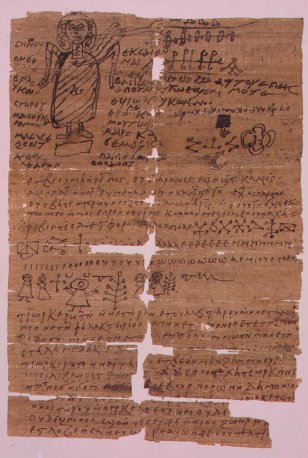Coptic Magical Papyrus
Overview
Coptic Magical Papyrus [ edit ]
The vicissitudes of life in the ancient Mediterranean often drove individuals to enlist the aid of greater powers, via amulets, incantations, and other ritually efficacious devices. Christian Egypt was no exception: texts of ritual power are extant from the entire period in which Coptic was in use, often integrating Christian deities and legends into earlier Egyptian traditions and ritual forms. In such texts, the mystical and phonetic qualities of letters are powerfully displayed: the Coptic alphabet is convenient for producing strings of magical sounds, and recognizable Coptic words appear side by side with inscrutable signs and symbols that draw upon the perceived power of ancient hieroglyphs.
This papyrus records two different spells. The upper text is a spell to obtain a beautiful singing voice. The petitioner is instructed to prepare special ink so as to inscribe a chalice with powerful signs. Next, the petitioner is told to procure a divination bowl and an offering, and recite a prayer to “Harmozel, the great ruler.” The conclusion of the prayer invokes the power of the Holy Trinity: “Yea, yea, for I adjure you by the left hand of the Father, I adjure you by the head of the Son, I adjure you by the hair of the Holy Spirit.” Harmozel is depicted as a winged angel; his trumpet emits strings of Coptic letters as he blows.
The second spell, on the lower part of the page, advertises itself as follows: “For a woman’s love, a really effective charm. Write these signs on a sheet of tin. Offering: wild herb, froth from the mouth of a completely black horse, and a bat. Bury it at the woman’s door. You will see its potency quickly.” Beneath the string of letters and signs to be copied onto the tin is an incantation addressed to celestial powers. In it, the petitioner adjures “Bersebour, the king of the demons” to render his victim “like a dog that is crazy for its pups”; in appropriate places, the petitioner would insert his own name and the name of the woman he sought to attract.
Period
6th-7th Centuries CE
Dimensions
37.3cm x 25.4 cm
Provenance
Egypt
Material
Papyrus
Museum
Beinecke Rare Book Library
Accession Number
P.CtYBR inv. 1791
Emmel, Stephen. “Previously Unpublished Coptic Texts of Ritual Power in the Beinecke Library, Yale University.” In Ancient Christian Magic: Coptic Texts of Ritual Power, edited by Marvin Meyer, Richard Smith, and Neal Kelsey, 345–358. San Francisco: HarperSanFrancisco, 1994.
Meyer, Marvin, Richard Smith, and Neal Kelsey, eds. Ancient Christian Magic: Coptic Texts of Ritual Power. San Francisco: HarperSanFrancisco, 1994.






















